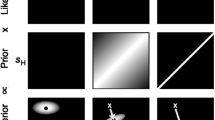Abstract
Perception is often discussed by reference to cues as separate sources of information for the perceiver [1]. With vision and audition, the list of such known cues is quite extensive [2, 3]. For example, visual depth perception in humans is thought to rely on monocular, oculomotor and binocular cues. Monocular depth cues include motion parallax, color contrast, perspective, relative size, relative height, focus, occlusion, shading, texture gradient, shadows, interreflections, and others. Oculomotor cues include accommodation and convergence. Binocular cues include disparity-based stereopsis. Such collections have been also identified for other object qualities such as size or color. With audition, say for object localization, there are analogous notions, such as interaural time difference, interaural intensity differences, or spectral cues related to head-related transfer functions, in addition to monaural cues [4].
Access this chapter
Tax calculation will be finalised at checkout
Purchases are for personal use only
Preview
Unable to display preview. Download preview PDF.
Similar content being viewed by others
Selected readings
Gibson JJ (1962) Observations on active touch. Psychological Review 69(6): 477–491
Jones LA, Lederman SJ (2006) Human hand function. Oxford University Press, Oxford
Pont SC, Kappers AML, Koenderink JJ (1999) Similar mechanisms underlie curvature comparison by static and dynamic touch. Perception & Psychophysics 61(5): 874–894
Goodwin AW, John KT, Marceglia AH (1991) Tactile discrimination of curvature by humans using only cutaneous information from the fingerpads. Experimental Brain Research 86(3): 663–672
Fearing RS, Binford TO (1988) Using a cylindrical tactile sensor for determining curvature. In: Proc. IEEE International Conference on Robotics and Automation, 765–771
Author information
Authors and Affiliations
Editor information
Editors and Affiliations
Rights and permissions
Copyright information
© 2008 Birkhäuser Verlag
About this chapter
Cite this chapter
Hayward, V. (2008). Haptic shape cues, invariants, priors and interface design. In: Grunwald, M. (eds) Human Haptic Perception: Basics and Applications. Birkhäuser Basel. https://doi.org/10.1007/978-3-7643-7612-3_31
Download citation
DOI: https://doi.org/10.1007/978-3-7643-7612-3_31
Publisher Name: Birkhäuser Basel
Print ISBN: 978-3-7643-7611-6
Online ISBN: 978-3-7643-7612-3
eBook Packages: Biomedical and Life SciencesBiomedical and Life Sciences (R0)




